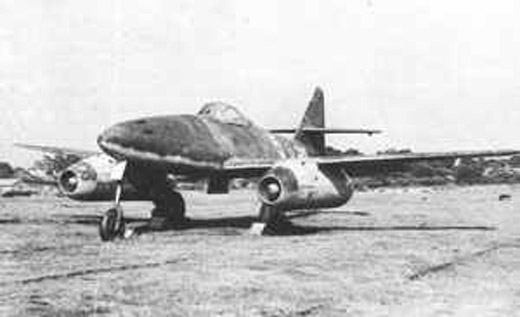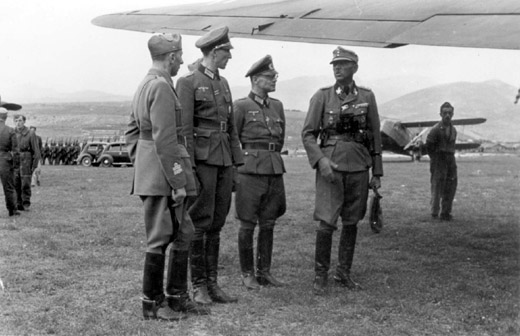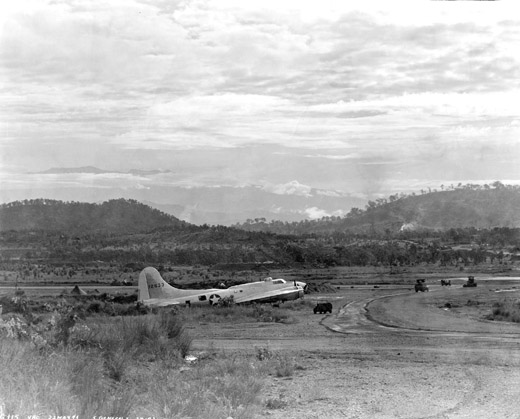Air Operations, Aleutians
The 11th Air Force is grounded by bad weather, but 19 G4M 'Betty' bombers armed with torpedoes attack a US cruiser and destroyer off Attu. No torpedo hits are scored and 2 'Bettys' are downed by antiaircraft fire.
Air Operations, Europe
BOMBER COMMANDDaylight Ops:
- 7 Mosquitos are sent to attack railway shops at Nantes, but turn back because of fighter opposition.
- There are no losses.
Air Operations, Mediterranean
- Allied bombers pound Sicily and Sardinia.
- A 14th Fighter Group P-38 downs a Bf-109 near Favignana Island, in the Egadi group.
Air Operations, New Guinea
90th Heavy Bomb Group B-24s attack Kaimana and motor launches off Koer Island.
[Air Operations, Solomons
2 XIII Fighter Command fighter pilots share in the downing of a G4M 'Betty' bomber near Rendova Island during an early-morning engagement.
[Aleutians
On Attu, the 3rd Battalion, 17th Infantry, on the southern front succeeds in taking the rest of the high ground penetrating into the valley that leads to Chichagof. Exploiting this success, the 2nd Battalion of the 32nd Infantry attacks in the afternoon and drives a wedge into the entrance of Chichagof Valley, the easiest approach to Chichagof. Patrol contact is made with the Northern Force, which remains in place, consolidating positions.
Whenever the weather permits, an important contribution is made by fire from the ships of Task Force 51, which, under cover from Task Force 16, was responsible for the landing operation. Task Force 51, commanded by Rear-Adm Francis W. Rockwell, consists of the old battleships Pennsylvania (BB-38) and Idaho (BB-42), 1 escort aircraft carrier, 6 cruisers and 18 destroyers.
[Allied Preparations
Urgent messages are sent to all headquarters concerned with the building of new airfields in Assam to get the work completed more quickly.
[
|
|
Battle of the Atlantic
Dönitz orders all U-boats on patrol in the north Atlantic to break off operations against the convoys. The losses have grown too high and although the Germans continue to hope for a revival of their fortunes by technical developments, the battle has effectively been won. Some boats are moved south to the Caribbean and to waters off the Azores. It is only by diverting his operations to less vital areas that Dönitz is able to continue his campaign, even at a reduced level.
The causes of the Allied victory are several: radar, aircraft and code-breaking information figure prominently. The U-boats can perform their operations best on the surface and when they are able to signal to each other. Air cover prevents them reaching their patrol positions quickly and they cannot shadow a convoy on the surface and signal its position without being detected and attacked. Messages from the U-boat Command can be decoded and U-boat patrols avoided and the favored tactics for night attacks are made difficult when radar ends the U-boat concealment. Altogether the Allies performance has been impressively coordinated, with scientists designing and airmen and sailors operating the weapons so quickly produced by industry. The only question over the Allied performance has been the way the maritime air services have had to compete with the strategic bomber forces for long-range aircraft. The Germans have been slow to realize the potential of their submarine force as the rate of building even as late as 1941 shows. Equally, they have been slower in fitting scientific developments into their operations.
Aircraft (VC-9) from the US escort carrier Bogue (CVE-9) sink the German submarine U-569 in the North Atlantic area.
| Class | Type VIIC |
| CO | Oberleutnant zur See Hans Johannsen |
| Location | N Atlantic, S of Cape Farewell |
| Cause | Air attack/scuttling |
| Casualties | 19 |
| Survivors | 24 |
CBI
INDIA:Gen Wheeler receives a directive calling for an expedited program of airfield construction in Assam.
[Germany, Home Front
- Adolf Galland, fighter 'ace' and 'General of Fighters', test flies the Me-262 jet fighters. He reports to Luftwaffe QMG Erhard Milch that if mass production of the jet is begun immediately, German can regain air superiority.
Messerschmitt Me-262 Fighter |
 |
Soviet Union, Politics
Moscow announces the dissolution of the Communist International (Comintern): '...long before the war, it became more and more clear that, with increasing cokmplications in internal and international relations of various countries, any sort of international center would encounter obstacles in solving the problems facing the movement in each separate country.' This is an act of goodwill intended to placate the very large section of public opinion in the West that are still nervous of dealings with Soviet Russia. The decision was made on May 15.
[
